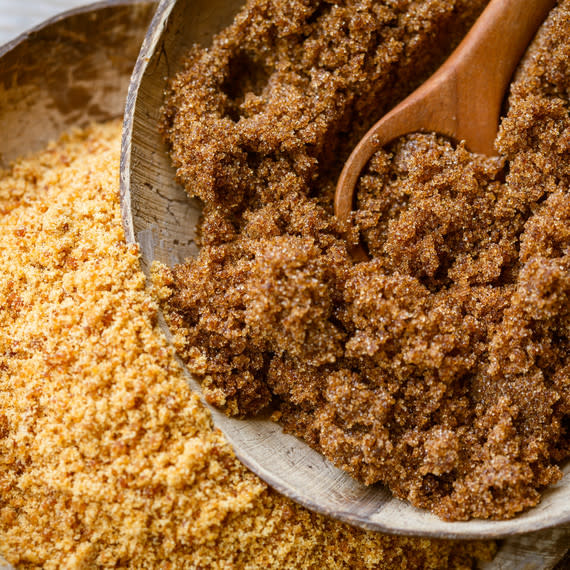How Are Dark and Light Brown Sugars Different?

Brown sugar adds a rich, sweet, and nutty flavor to baked goods and desserts (and even some savory dishes, too). Molasses is the key ingredient that distinguishes brown sugar from granulated sugar, and it's this ingredient that makes brown sugar shine in banana bread, gingerbread cookies, and so much more. But aside from color, is there really a difference between light and dark brown sugars? And what about other sugars that are brown in color but texturally different, such as demerara, muscovado, and turbinado sugar—how do they fit in to the mix?
Related: Everything You Need to Know About Flour, From All-Purpose to Whole-Wheat
Light Brown Sugar
Light brown sugar is the most common of the five sugars we'll discuss. It's made by mixing together refined white sugar with a small amount of molasses (something you can DIY in a pinch at home). Light brown sugar gets its color, caramel-y flavor, and moist texture from molasses. Typically, the light brown sugar available in the grocery store is made with three and a half percent molasses. Try light brown sugar in this Bourbon-and-Brown-Sugar Cake with Berries, Brown-Sugar Butternut-Squash Pie, and Buckwheat Chocolate-Chip Cookies with Sea Salt.
Dark Brown Sugar
Dark brown sugar is made and used the same way as light brown sugar, but contains a higher level of molasses. This not only makes the final product a darker shade of brown, but also enhances its rich flavor. It contains nearly double the amount of molasses compared to light brown sugar (approximately six and a half percent). Dark brown sugar is generally called for in recipes that have a pronounced caramel flavor, such as Brown-Sugar-and-Bacon-Glazed Brussels Sprouts and Milk Tart with Brown Sugar Crust.
Muscovado Sugar
Muscovado sugar is the most similar in moistness, flavor, and color to light and dark brown sugars. It is an unrefined cane sugar with naturally occurring molasses and is usually more expensive that light and dark brown sugar. It adds a super-rich, roasted flavor to recipes when used so definitely don't shy away from stocking up on it.
Turbinado Sugar
Turbinado sugar is less processed than brown sugar and is the immediate result of the first pressing of sugar cane. It's also known as raw sugar. (Ever used a raw sugar packet at a coffee shop? That's turbinado sugar.) It has a much larger grain than light brown or dark brown sugar and is drier than both. Don't substitute turbinado for for light or dark brown sugar as its large grain size could throw off your recipe. If you do want to use it in place of other brown sugars, make sure it will dissolve easily, or just sprinkle as a garnish atop baked goods like Morning Glory Muffins.
Demerara Sugar
Demerara sugar is similar to turbinado sugar, but with lighter colored, larger, drier crystals. It's a popular raw sugar for mixing into beverages or as an alternative to sanding sugar. It's less refined than the white sugar used to create both light and brown sugar and is the subject of debate among nutritionists about which type of sugar is better for you.
(function(d, s, id) { if (d.getElementById(id)) return; var js = d.createElement(s); js.id = id; js.src = '//cdn4.wibbitz.com/static.js'; d.getElementsByTagName('body')[0].appendChild(js); }(document, 'script', 'wibbitz-static-embed'));
